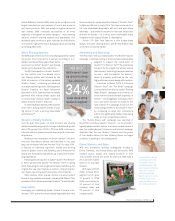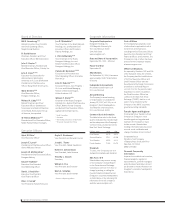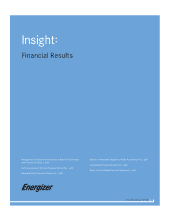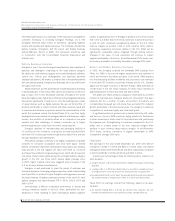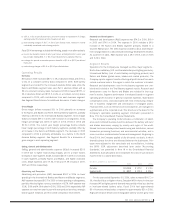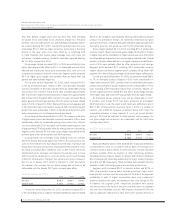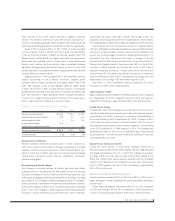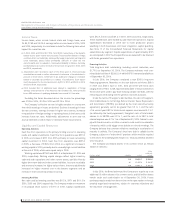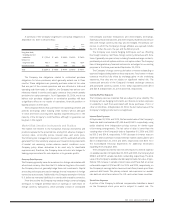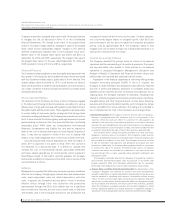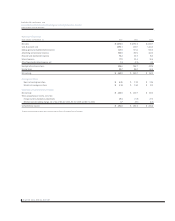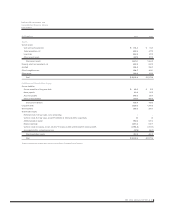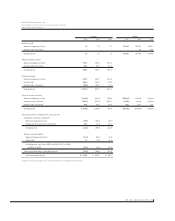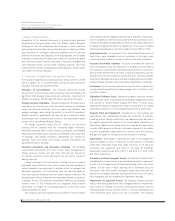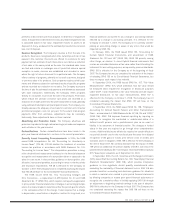Energizer 2006 Annual Report Download - page 19
Download and view the complete annual report
Please find page 19 of the 2006 Energizer annual report below. You can navigate through the pages in the report by either clicking on the pages listed below, or by using the keyword search tool below to find specific information within the annual report.
ENR 2006 ANNUAL REPORT 17
tions. In determining the discount rate, the Company uses the yield on
high-quality bonds that coincides with the cash flows of its plans’ estimated
payouts. For the U.S. plans, which represent the Company’s most significant
obligations, the CitiGroup yield curve is used in determining the discount rates.
Of the assumptions listed above, changes in the expected assets return
have the most significant impact on the Company’s annual earnings prospec-
tively. A one percentage point decrease or increase in expected assets return
would decrease or increase the Company’s pre-tax pension expense by $6.9.
As allowed under U.S. GAAP, the Company’s U.S. qualified pension plan
uses Market Related Value (MRV), which recognizes market appreciation or
depreciation in the portfolio over five years so it reduces the short-term impact
of market fluctuations.
Valuation of Long-Lived Assets The Company periodically evaluates its long-
lived assets, including goodwill and intangible assets, for potential impairment
indicators. Judgments regarding the existence of impairment indicators are
based on legal factors, market conditions and operational performance.
Future events could cause the Company to conclude that impairment indicators
exist. The Company typically uses the discounted cash flows method to deter-
mine if impairment exists. This requires management to make assumptions
regarding future income, working capital and discount rates, which would
affect the impairment calculation.
Income Taxes The Company estimates income taxes and the income tax rate
in each jurisdiction that it operates. This involves estimating taxable earnings,
specific taxable and deductible items, the likelihood of generating sufficient
future taxable income to utilize deferred tax assets and possible exposures
related to future tax audits. Deferred tax assets are evaluated on a subsidiary
by subsidiary basis for realizability. Valuation allowances are established when
the realization is not deemed to be more likely than not. Future performance
is monitored, and when objectively measurable operating trends change,
adjustments are made to the valuation allowances accordingly. To the extent
the estimates described above change, adjustments to income taxes are made
in the period in which the estimate is changed.
Accounting Standards
The Company adopted SFAS No. 123 (revised 2004), “Share-Based
Payment” (SFAS 123R), using the “modified retrospective” method.
Accordingly, prior years results have been adjusted to incorporate the
effects of SFAS 123R, as reflected in Note 18 to the Consolidated Financial
Statements. The impact to the Company’s net earnings is consistent
with the pro forma disclosures provided in previous financial statements.
See discussion in Note 2 to the Consolidated Financial Statements
related to recently issued accounting standards.
Forward-Looking Information
Statements in the Management’s Discussion and Analysis of Results of
Operations and Financial Condition and other sections of this Annual
Report to Shareholders that are not historical, particularly statements
regarding the health of the battery category, the impact of changes in
the value of local currencies on segment profitability, Energizer’s
estimates of its share of total U.S. retail battery market and SWS share
of the wet shave category in major markets, Energizer’s positioning to
meet consumer demand and the benefits of its portfolio of products,
continuing increases in the cost of key commodity metals, the ability
of announced battery price increases to offset those increases, the impact
of such increases on per unit gross margins, the Company’s anticipated
charges and annualized cost savings from European restructuring
projects, future tax rates, estimated capital expenditures for fiscal 2007
and their source of financing, the likelihood of acceleration of the
Company’s debt covenants, the anticipated adequacy of cash flows and
the Company’s ability to meet liquidity requirements, the Company’s
ability to mitigate future material, labor and transportation cost increases,
the materiality of future expenditures for environmental matters and
environmental control equipment, the impact of adverse changes in
interest rates, the market risk of foreign currency derivatives, the
mitigating impact of changes in value of the prepaid share option on
deferred compensation liabilities, potential adjustments to accruals for
promotional program costs, the impact of variations from assumptions
on pension asset returns on the Company’s pre-tax pension expense,
and the valuation of long-lived assets, may be considered forward-
looking statements within the meaning of the Private Securities
Litigation Reform Act of 1995. The Company cautions readers not to
place undue reliance on any forward-looking statements, which speak
only as of the date made.
The Company advises readers that various risks and uncertainties
could affect its financial performance and could cause the Company’s
actual results for future periods to differ materially from those antici-
pated or projected. Battery consumption trends could be negatively
impacted by general economic conditions or product innovations.
Global economic conditions and fluctuations in currency exchange
rates could significantly impact current exchange rates, resulting in
a more significant impact on segment profitability than is currently
anticipated. Energizer’s estimates of its U.S. alkaline market share and
estimates of SWS share of the wet shave category are based solely on
limited data available to the Company and management’s reasonable
assumptions about market conditions, and consequently may be
inaccurate, or may not reflect segments of the retail market. Shifts in
consumer demands or needs, competitive activity or product improve-
ments, or further retailer consolidations may dilute or defeat the
benefits of the Company’s consumer positioning and strategy.
Competitive promotional activity, or pricing or promotional demands
from retailer customers, could limit the efficacy of battery price increases
in future periods, while, on the other hand, manufacturing efficiencies
and efforts to further reduce costs could have a favorable impact on the
Company’s production costs. The impact of commodity cost increases,
nevertheless, could be more significant than anticipated, as it is difficult
to predict with any accuracy whether raw material, energy and other
input costs will stabilize or continue to increase, since such costs are
impacted by multiple economic, political and other factors outside of
the Company’s control. With respect to the European restructuring and
integration projects, the integration aspects are still under evaluation
and review, and anticipated charges and cost savings are preliminary.
Additional costs associated with restructuring or unexpected expenses
associated with integration activities may lead to higher than anticipated
charges to earnings, and estimates of annual savings may be impacted
by a number of factors, including limits on available efficiencies, unfore-
seen integration complexities, and greater than anticipated ongoing
operating expenses associated with the combined operations.
Unforeseen fluctuations in levels of the Company’s operating cash
flows, or inability to maintain compliance with its debt covenants, could


